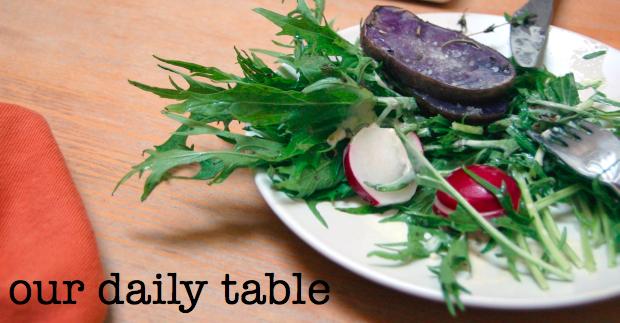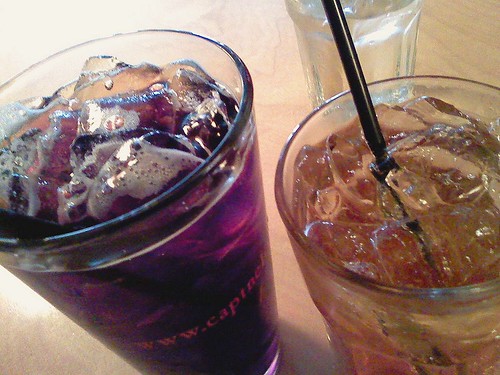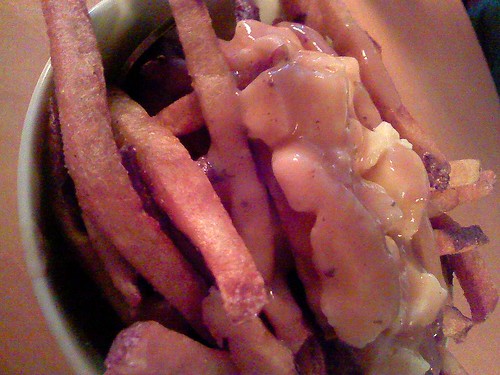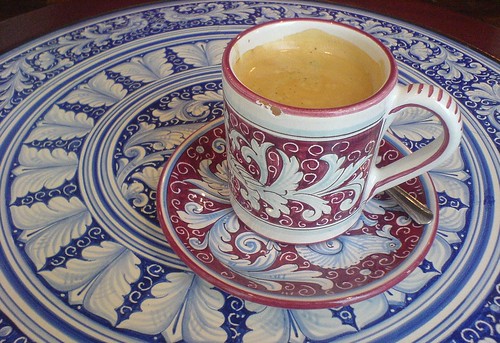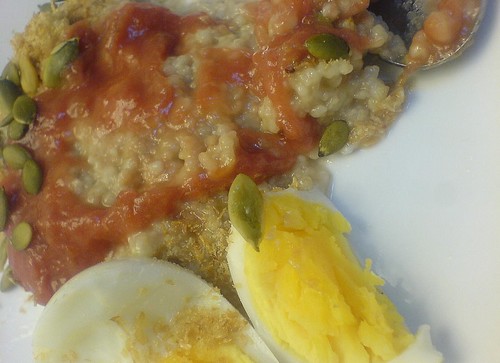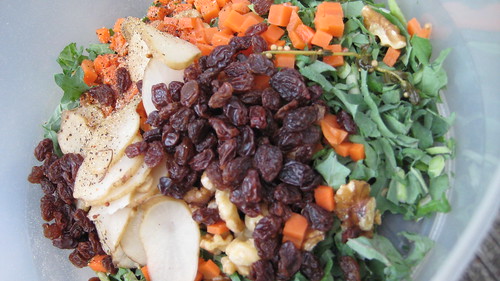I have a problem with French fries. And like so many problems, it took me a while to realize that things were getting out of hand. They used to be an indulgence, a side for the occasional burger or sandwich. Even then, I'd sometimes be strong and substitute a salad, knowing that fried food -- like red meat and raw cookie dough -- should be consumed in moderation. Then I started working at a restaurant that cut its own fries, and I started to slip. At the end of the night, I'd sneak a few from the fryer (they just sit there, waiting for their death by garbage). I'd anticipate the nights the staff was served them for dinner, and if I had a craving, I knew I could order a batch, crunchy and salty and made from potatoes, which are clearly my ambrosia. Thick, thin, crisped to a brown, sagging with grease, salted, peppered, doused with Tabasco, even baked (which in my heart of hearts seems extremely wrong), I love French fries.
Try to imagine, then, the joy (and the impatience) I felt when Ellen tipped me off to Duckfat in Portland, Maine. A quick look at the restaurant's Web site will tell you everything you need to know: owned and operated by the renowned Hugo's folks, this little eatery is celebrated for its fries and sandwiches. Make that Belgian fries and panini with ingredients of duck confit, meatloaf and tongue. They also serve soups and salads, beignets and churros, and a "Five dollar" milk shake that will set you back a cool $4. But the real star of the menu, and the thing I sought out on my recent trip, was Duckfat's poutine.
If I were on death row and offered the choice of a final meal, Duckfat's poutine might just be it. This seems fitting because, in a way, it sort of was. Before my trip, in a moment of inspiration (or perhaps guilt or panic) I vowed to give up French fries. Not forever, but for the summer, I decided. Like I said before, moderation is key. Besides, there have to be some satisfying alternatives to salad and slaw. I want to find them. But first:
Poutine is essentially cheese fries, only in Quebec, where the dish hails from, the fries are topped with fresh cheese curd* and gravy. I learned of poutine on a trip to Montreal a few years ago, but have never seen it stateside. Duckfat's version is far better than anything I had north of the border: medium-sized fries cut in-house, fried in duck fat, then topped with nice big chunks of cheese curd and a thick, slightly peppery, duck gravy. It sounds insane...because it is. My friend and I were actually embarrassed to be splitting an order and a panino, until the couple next to us ordered two. We had no problem then justifying an order of beignets and a pot of coffee, never mind I'd already had a house-made cream soda.
* Not unlike cottage cheese, a friend tells me they actually sell this stuff by the bagful -- "like popcorn" -- at the Madison, Wis., airport.
Tuesday, June 9, 2009
Friday, June 5, 2009
Rhubarb. I never knew.
I've been distracted all morning by the rain falling loudly outside my open windows, the sounds of the passing cars singing that wet pavement tune that always reminds me of home. Rain in Brooklyn is different than rain in Portland, Ore. In Portland, you come to expect the rain the way you do a good cup of coffee: always just around the corner. Here, the rain sneaks up on you like a bat out of hell. In the late-spring and early-summer, the sky grows dark seconds before a dirty and violent storm descends, flooding the streets and subways. It's the kind of rain that demands an umbrella, that awkward accessory weathered Oregonians shun. It unearths complainers.
For the last three years I've doubted whether or not I'll ever get used to New York rain. Now, I'm beginning to think I don't want to. Associating rain with a double Americano (like the one I snapped above at La Colombe coffee in Philadelphia), NPR and tummy-warming foods brings me great joy, which is why, this morning, instead of a quick egg or a scoop of hummus on toast, I treated myself to a bowl of oatmeal with rhubarb compote and pumpkin seeds.My love affair with rhubarb is a new thing, borne as much from my love of all things pie as my commitment to all things local. A few weeks ago at the farmer's market, bored of apples and impatient for summer berries, I picked up a few stalks for fun. Then I trekked home and realized I had no idea how to use them. On a friend's recommendation, I sprinkled some salt on a stalk for a quick snack, but it was much too tart for my palette. Not wanting to labor over a pie and not wanting to waste, I did a quick online search and turned up this recipe courtesy of Tasting Menu.
Try as I might, the above picture does not do this compote justice. It's a color that, in artificial form, would be revolting, really. Pinker than salmon, browner than orange, it's gorgeous, and when cooked down a little longer than the recipe recommends, it takes on a unexpected creaminess. Dolloped on oats, smeared on a bagel, served alongside cheese, it's no wonder people rave about it's versatility. Out of sheer excitement, I gifted most of my first batch. Thankfully, rhubarb is available locally for a few more months, giving me plenty of time to stock up on compote before the real rain comes fall.
Thursday, June 4, 2009
They're called fiddleheads and they're delicious.
While planning my trip to Maine, I stumbled upon this post at the lovely Last Night's Dinner that both tempted and inspired. I'll never forget the first time I encountered fiddleheads. It was in the spring of 2004 and I had recently moved to Nantucket, Mass., for the summer. The restaurant where I worked was pairing fiddleheads with the night's fish addition and I had to admit to the chef I'd never heard of -- let alone tasted -- the funky green ferns. Throughout the night, as I told my tables about the evening's additions and witnessed the enthusiasm over this mystery vegetable, I got the feeling I was missing out on one of Mother Nature's best-kept secrets. Later that night, as I bit into the crunchy green -- buttery and salty from the sauté pan -- my suspicions were confirmed. Often compared in flavor to asparagus, fiddleheads are delightfully strange and satisfying on the tongue, and they instantly make a playful plate. Not only that, but they serve as a reminder of the goodness we can find locally.
In Maine (fiddleheads are reportedly common across New England, as well as Asia; Australia and New Zealand; Michigan; and Ontario, Canada), fiddlehead season runs roughly six weeks starting in April. Throughout my trip, I saw and tasted them as often as I could (tossed with farfalle, lemon zest and ricotta salata at Chase's Daily in Belfast; sautéed with butter and served alongside a gorgeous filet of halibut and pickled ramps at Bresca in Portland), and I bought a bagful at the fabulous Belfast Co-Op to experiment with on the camp stove.
Because I wanted to highlight the fiddleheads, and because we'd indulged in a rather large lunch of lobster rolls, onion rings, locally-brewed beer and pie (I had strawberry-rhubarb with vanilla ice cream, my friend had blueberry with wild Maine blueberry ice cream -- Oy!) at the Docksider in Northeast Harbor, I opted to use the ferns in a light dinner of quinoa salad. Quinoa is so easy and delicious, cooking in about 10 minutes, and it's healthy, too. I use it often for simple salads such as this one.
While I boiled some water and cooked the quinoa, I chopped some young kale, pickled carrots and raw shallot. Then in a bowl, I mixed roughly a handful of each of the following: kale (leaves and stems); the pickled carrots and some amazing pickled sunchokes courtesy of Get Fresh Table and Market; raw raisins; and raw walnuts. To this, I added the cooked quinoa and set aside.
In a separate pan, I sautéed the fiddleheads* and shallot in olive oil until tender (roughly 10-12 minutes), then added to the mixture. All of this I tossed with fresh lemon, sea salt and pepper for a simple and satisfying meal. The tanginess of the pickled carrots and sunchokes, paired with the earthy crunch of the fiddleheads and raw kale, and the sweetness of the raisins, is worth recreating. Had I thought of it soon enough I would have packed some fiddleheads home for freezing and pickling. Until next year, I'll make salads such as this one with whatever seasonal produce I can get my hands on.
* Note: Because of numerous outbreaks of food-borne illness associated with eating fiddleheads, the ferns should be thoroughly cleaned and either boiled for 10 minutes or steamed for 20 minutes before eating. I found this article extremely useful.
In Maine (fiddleheads are reportedly common across New England, as well as Asia; Australia and New Zealand; Michigan; and Ontario, Canada), fiddlehead season runs roughly six weeks starting in April. Throughout my trip, I saw and tasted them as often as I could (tossed with farfalle, lemon zest and ricotta salata at Chase's Daily in Belfast; sautéed with butter and served alongside a gorgeous filet of halibut and pickled ramps at Bresca in Portland), and I bought a bagful at the fabulous Belfast Co-Op to experiment with on the camp stove.
Because I wanted to highlight the fiddleheads, and because we'd indulged in a rather large lunch of lobster rolls, onion rings, locally-brewed beer and pie (I had strawberry-rhubarb with vanilla ice cream, my friend had blueberry with wild Maine blueberry ice cream -- Oy!) at the Docksider in Northeast Harbor, I opted to use the ferns in a light dinner of quinoa salad. Quinoa is so easy and delicious, cooking in about 10 minutes, and it's healthy, too. I use it often for simple salads such as this one.
While I boiled some water and cooked the quinoa, I chopped some young kale, pickled carrots and raw shallot. Then in a bowl, I mixed roughly a handful of each of the following: kale (leaves and stems); the pickled carrots and some amazing pickled sunchokes courtesy of Get Fresh Table and Market; raw raisins; and raw walnuts. To this, I added the cooked quinoa and set aside.
In a separate pan, I sautéed the fiddleheads* and shallot in olive oil until tender (roughly 10-12 minutes), then added to the mixture. All of this I tossed with fresh lemon, sea salt and pepper for a simple and satisfying meal. The tanginess of the pickled carrots and sunchokes, paired with the earthy crunch of the fiddleheads and raw kale, and the sweetness of the raisins, is worth recreating. Had I thought of it soon enough I would have packed some fiddleheads home for freezing and pickling. Until next year, I'll make salads such as this one with whatever seasonal produce I can get my hands on.
* Note: Because of numerous outbreaks of food-borne illness associated with eating fiddleheads, the ferns should be thoroughly cleaned and either boiled for 10 minutes or steamed for 20 minutes before eating. I found this article extremely useful.
Tuesday, June 2, 2009
The way life should be, indeed.
Last week I returned home from a much-needed vacation in Maine, where I mainly (forgive me) ate and drank and slept and ate some more. It was glorious, not just because it was filled with my favorite things, but because the variety of ways in which I traveled proved that fine food and drink are easy to have, whether camping in a national park, cruising down the coast or living it up in the state's largest city. Planning proved as much of a necessity as impulse.
Maine has been on my radar for years, ever since a chef friend of mine left a prestigious gig in Boston for Portland's burgeoning (nay bourgeois) restaurant scene. And I'm not the only one. No sooner was the trip on the calendar than recommendations started pouring in from friends, co-workers past and present, even strangers. How, I wondered, could I possibly squeeze four lobster rolls into a week's time, plus what was rumored to be the world's best wild blueberry ice cream and coconut cream pie? What about the cooking I wanted to do? And the handful of Portland restaurants I wanted to check out?
So many meals, so little time, hardly a problem. Especially in Maine, "the way life should be".
The weeks leading up to my vacation were especially taxing, so my plan for Acadia National Park was simple: cook and eat the way I like. I packed various dry goods, such as farina, pasta and quinoa; nuts and seeds; and good olive oil and salt. I also brought a jar of mixed olives, a nice hard salami and a big hunk of Parmigiano-Reggiano courtesy of the folks at Bedford Cheese Shop, and a half-dozen lemons because I can't live without them. Finally, I brought money to shop along the way. In Belfast, Maine, my friend and I stopped by the co-op to get some local goodness, which was abundant. Bok choy, fiddleheads, young kale, all gorgeous and green, found their way into my basket, as did some pork chops and coffee. The last hour of the drive had me squirming with possibility, not to mention just plain hungry.
Upon arrival, we quickly set up camp and started a fire. During that time, I also brought a small pot of water to a boil on our awesome and indispensable camp stove. While the pasta was cooking, I washed and chopped the soft, young kale and used a paring knife to chip some nice chunks of cheese. To this I added a generous handful of pumpkin seeds, the juice of half a lemon and a drizzle of olive oil.
Simultaneously, the fire had grown hot enough to grill the pork chops, which I had rubbed with a little olive oil, salt and pepper. Cooking food over an open flame, whether it be pork, marshmallows, even bread, is pretty much the best thing ever, at least that's how I continue to feel about our meal that night. By the time the meat was seared, the pasta was done. Combined with the kale, etc., and plated cowboy style in a pie tin, we felt like rouge foodies. Our neighbors might have been snickering at our wine glasses, but you can't drink Montepulciano -- even a bargain one -- out of plastic. And why should we have? It's vacation.
Maine has been on my radar for years, ever since a chef friend of mine left a prestigious gig in Boston for Portland's burgeoning (nay bourgeois) restaurant scene. And I'm not the only one. No sooner was the trip on the calendar than recommendations started pouring in from friends, co-workers past and present, even strangers. How, I wondered, could I possibly squeeze four lobster rolls into a week's time, plus what was rumored to be the world's best wild blueberry ice cream and coconut cream pie? What about the cooking I wanted to do? And the handful of Portland restaurants I wanted to check out?
So many meals, so little time, hardly a problem. Especially in Maine, "the way life should be".
The weeks leading up to my vacation were especially taxing, so my plan for Acadia National Park was simple: cook and eat the way I like. I packed various dry goods, such as farina, pasta and quinoa; nuts and seeds; and good olive oil and salt. I also brought a jar of mixed olives, a nice hard salami and a big hunk of Parmigiano-Reggiano courtesy of the folks at Bedford Cheese Shop, and a half-dozen lemons because I can't live without them. Finally, I brought money to shop along the way. In Belfast, Maine, my friend and I stopped by the co-op to get some local goodness, which was abundant. Bok choy, fiddleheads, young kale, all gorgeous and green, found their way into my basket, as did some pork chops and coffee. The last hour of the drive had me squirming with possibility, not to mention just plain hungry.
Upon arrival, we quickly set up camp and started a fire. During that time, I also brought a small pot of water to a boil on our awesome and indispensable camp stove. While the pasta was cooking, I washed and chopped the soft, young kale and used a paring knife to chip some nice chunks of cheese. To this I added a generous handful of pumpkin seeds, the juice of half a lemon and a drizzle of olive oil.
Simultaneously, the fire had grown hot enough to grill the pork chops, which I had rubbed with a little olive oil, salt and pepper. Cooking food over an open flame, whether it be pork, marshmallows, even bread, is pretty much the best thing ever, at least that's how I continue to feel about our meal that night. By the time the meat was seared, the pasta was done. Combined with the kale, etc., and plated cowboy style in a pie tin, we felt like rouge foodies. Our neighbors might have been snickering at our wine glasses, but you can't drink Montepulciano -- even a bargain one -- out of plastic. And why should we have? It's vacation.
Subscribe to:
Posts (Atom)
